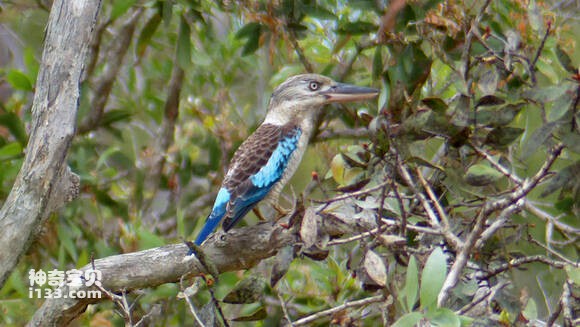Dacelo leachii
IUCN
LCBasic Information
Scientific classification
- name:Dacelo leachii
- Scientific Name:Dacelo leachii,Blue-winged kookaburra
- Outline:Climbing birds
- Family:
Vital signs
- length:38-45cm
- Weight:No textual research information is available
- lifetime:No textual research information is available
Feature
The head is out of proportion to the rest of the body, the neck thick, powerful mouth dagger-shaped
Distribution and Habitat
The blue-winged Kookaburra is found in Australia and New Zealand (including Australia, New Zealand, Tasmania and nearby islands).
The blue-winged Kookaburra occupies a much smaller range than the kookaburra, also in Queensland, Australia. However, it is limited to about 100 kilometers along Australia's long northern coast and does not penetrate the interior of the continent. Preferred habitats include open eucalyptus forests, but also on large farms or in suburban parks located in cities. The household size ranges from 1 to 4 acres, or 0.4 and 1.6 hectares.
Appearance
The blue-winged kookaburra is slightly smaller than the kookaburra, 38-45 cm long, and its habits are roughly equivalent to the kookaburra. Like all hunting kingfishers, the name of the blue-winged Kookaburra is an important element in identifying it, with its head out of proportion to the rest of its body, a thick neck, and a powerful dagger-shaped beak. The short tail. The upper body is brown, the lower body is off-white. Blue wings with thick livid gray eye stripes. White eyes, white eyebrows. In addition, the rump and tail are different shades of blue. The tip of the wings is covered with dark blue, which is the most important characteristic to identify the blue-winged Kookaburra.
Mouth thick straight, long and firm, mouth ridge round; No nasal furrow; The wingtip is long, the first primary feathers are slightly shorter, and the third and fourth feathers are longest; Tail short round; The body feathers are showy and luminous, often blue or green. The head is large, the neck is s
Details
The Blue-winged kookaburra has four subspecies, Dacelo leachii and blue-winged Kookaburra。

The calls of the blue-winged kookaburra resemble calls, coughs, murmurs, and laughter. Parents teach young birds to learn to beat defeated prey to death on a rock or tree branch. They also spend a lot of time teaching and helping the birds learn to cry. The whole family is an independent living unit.
Although the blue-winged kookaburra is included in the range of fish-eating birds, its diet is very varied. A wide variety of small land animals, including insects (grasshoppers, beetles, cockroaches), snails, lizards, snakes, and small mice. Of course, they like small fish best, but they also include amphibians, Australian shrimp and crabs. If food is scarce, the blue-winged kookaburra usually attacks other birds, capturing and robbing eggs and young birds. The food is not fully digested, and in its stomach ball there are membranous wings of insects, shells, fur, and bones.

Every August the blue-winged Kookaburra, which is active in New South Wales, returns to Queensland to breed, first looking for nesting places. Generally choose a tree that has been emptied by termites, and peck a hole with a powerful beak. They may also choose a nest that has been used in previous years, up to 15 years. The blue-winged Kookaburra is monogamous and lives together. During the breeding season, subadult females live in family groups, and males are excluded from the family after their first year. In Queensland in September or early October, the female lays three or four white eggs, which hatch for 25 days.
Listed on the International Union for Conservation of Nature (IUCN) Red List Protection Level: Not Threatened (LC).
Protect wild animals and eliminate wild meat.
Maintaining ecological balance is everyone's responsibility!








